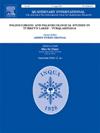The Middle Stone age fauna from the DC member of Cave 1B at Klasies River main site, South Africa: Animal exploitation during the MSA II
IF 1.8
3区 地球科学
Q3 GEOGRAPHY, PHYSICAL
引用次数: 0
Abstract
Klasies River main site (KRM) is a prominent Middle Stone Age (MSA) site located on the southern Cape coast in the Eastern Cape province of South Africa. This contribution discusses the animal remains from the DC member in Cave 1B not reported on before. These animals fall within MSA II (Mossel Bay) techno-complex that, at KRM, dates from before 110 to 78ka. Despite heavy fragmentation, the fauna from this period shows a variety of taxa, including mammals, birds, reptiles, amphibians, fish and molluscs. The most common taxa in the sample include indeterminate medium and small mammals, tortoises, indeterminate small birds, Cape fur seals, and indeterminate Bovid I and II's. The presence of several stacked hearths, shellfish, lithics and burnt and butchered bones all suggest that humans were the main agent of accumulation of the fauna. This is further supported by low values for the carnivore-ungulate ratio, the carnivore richness- and the leopard index, which measures the probabilities of brown hyena, leopard and human accumulations. However, the presence of chew marks presumably caused by carnivores suggests brown hyenas or leopards accumulated, or had access to some fauna. Assuming that humans accumulated most fauna, there is evidence of a summer occupation at KRM during the MSA II. People were exploiting a variety of environments during the MSA II, including coastal dunes, grasslands, savanna woodlands and closed, bush environments. During the MSA II at KRM, people focused on hunting ungulates.
南非Klasies河主遗址1B洞DC成员的中石器时代动物群:MSA II期间的动物开发
克拉西斯河主要遗址(KRM)是一个突出的中石器时代(MSA)遗址,位于南非东开普省的南开普海岸。这篇文章讨论了以前没有报道过的洞穴1B中DC成员的动物遗骸。这些动物属于MSA II(莫塞尔湾)技术综合体,在KRM,可以追溯到110到78ka之前。尽管破碎程度严重,但这一时期的动物群显示出多种分类群,包括哺乳动物、鸟类、爬行动物、两栖动物、鱼类和软体动物。样本中最常见的分类群包括不确定的中小型哺乳动物、陆龟、不确定的小型鸟类、角毛海豹和不确定的牛科动物I和II。堆在一起的壁炉、贝类、石器和烧焦和屠宰的骨头都表明,人类是动物群聚集的主要因素。食肉动物与有蹄类动物的比例、食肉动物的丰富度和豹子指数(衡量棕色鬣狗、豹子和人类聚集的概率)的低值进一步支持了这一观点。然而,可能是食肉动物造成的咀嚼痕迹表明,棕色鬣狗或豹子聚集在一起,或者接触过一些动物。假设人类聚集了大部分动物,有证据表明,在MSA II期间,KRM有夏季占领。在MSA II期间,人们正在开发各种环境,包括沿海沙丘,草原,稀树草原林地和封闭的灌木丛环境。在KRM的MSA II期间,人们专注于狩猎有蹄类动物。
本文章由计算机程序翻译,如有差异,请以英文原文为准。
求助全文
约1分钟内获得全文
求助全文
来源期刊

Quaternary International
地学-地球科学综合
CiteScore
5.60
自引率
4.50%
发文量
336
审稿时长
3 months
期刊介绍:
Quaternary International is the official journal of the International Union for Quaternary Research. The objectives are to publish a high quality scientific journal under the auspices of the premier Quaternary association that reflects the interdisciplinary nature of INQUA and records recent advances in Quaternary science that appeal to a wide audience.
This series will encompass all the full spectrum of the physical and natural sciences that are commonly employed in solving Quaternary problems. The policy is to publish peer refereed collected research papers from symposia, workshops and meetings sponsored by INQUA. In addition, other organizations may request publication of their collected works pertaining to the Quaternary.
 求助内容:
求助内容: 应助结果提醒方式:
应助结果提醒方式:


